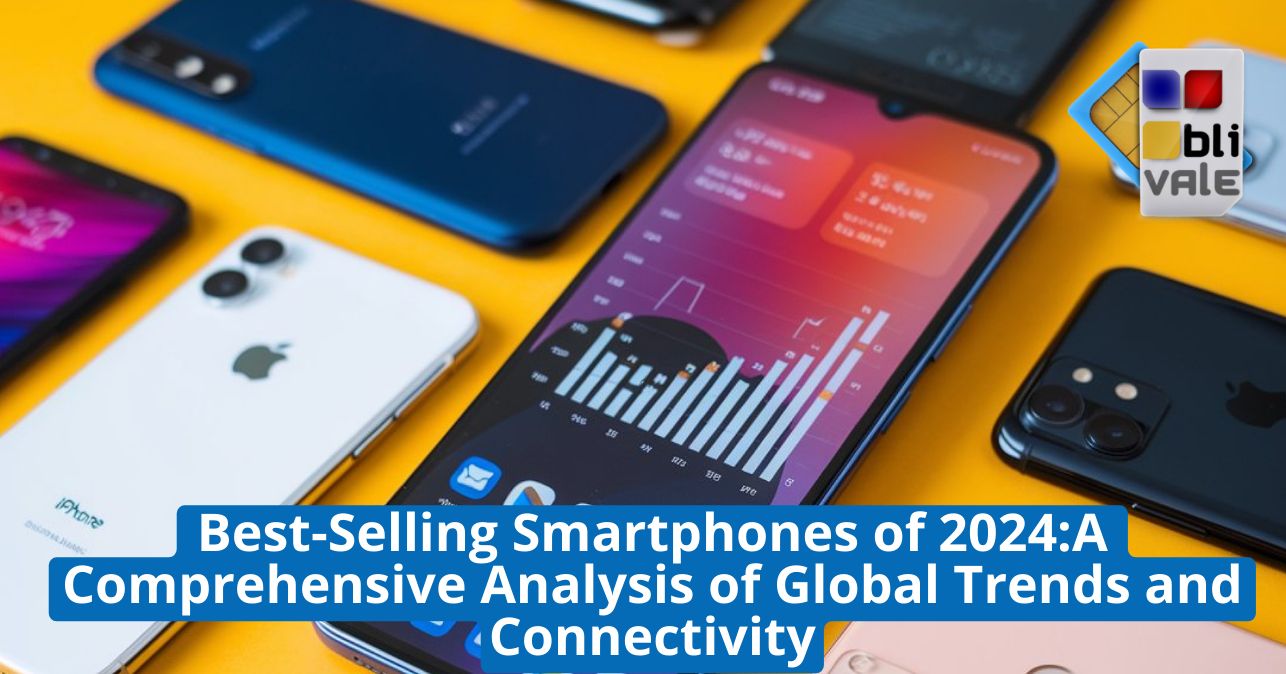2024 has proven to be an exciting year for the smartphone market, with several new features and innovations that have captured the attention of users across the globe. In this article, we will explore which smartphone models have been the best-selling, their connectivity features, and how operating systems have influenced users' choices. If you are curious about which smartphones have dominated the market and why, you are in the right place.
Best Selling Smartphone Models
In recent months, global sales have clearly shown which brands and models have managed to win the hearts of users. According to statistics, Apple, Samsung and Xiaomi continue to be the main protagonists, with models that stand out for technological innovation and effective marketing strategies.
Complete table for all smartphones sold in 2024.
The data shows that the top smartphones sold globally are mainly from Apple, Samsung and Xiaomi, with variations in regional preferences.
Here is an overview based on the main models and the information available:
These models reflect a growing trend towards eSIM support, especially in premium devices, while mid-range and low-end models tend to retain the SIM card for reasons of affordability and regional accessibility.
Apple: The Kings of the High-End. At the top of the list is the iPhone 15 Pro Max, with sales of around 95 million units. This model has attracted users thanks to its excellent camera and high performance. The iPhone 15 Pro has also achieved remarkable results, with around 80 million units sold. Both models support both eSIM and SIM Card, but in the United States they are only available in eSIM version.
Samsung: Innovation and Versatility. Samsung confirms itself as a giant in the market, especially with the Galaxy S24 Ultra, which has recorded sales of around 60 million units. This smartphone stands out for its versatility, supporting both SIM Card and eSIM. The Galaxy A14 has also been successful, selling around 45 million units thanks to its competitive price and solid features.
Xiaomi: Affordability and Quality. Xiaomi continues to gain traction, especially in the more affordable market segments. The Redmi Note 13 has sold around 50 million units, proving that users are also looking for affordable devices without compromising on quality. This model, along with others like the Galaxy A14, shows that the SIM Card remains a popular choice among budget-conscious consumers.
Table with quantities sold by model and support for physical SIMs, eSIMs or both.
Data reflects Q3 2024.
Regional Preferences and OS Dominance: The Global Smartphone Map in 2024
Regional Trends in the Smartphone Market
Another interesting element is how user preferences vary significantly from region to region. In the US, Apple continues to dominate with its premium models, while in Asia-Pacific we see strong growth for Chinese brands such as Vivo and Xiaomi. In Europe, users seem to prefer a mix between Apple's premium devices and Samsung's mid-range ones.
North America: Apple's Strength. In the United States, the iPhone 16 Pro sold around 20 million units, signaling a strong interest in premium smartphones. The iPhone 16 also saw notable sales with around 15.5 million units. This trend highlights how American users are willing to invest in expensive devices that promise high performance.
Europe: A Mix of Preferences. In Europe, the situation is more balanced. The Galaxy A54 and A14 models have established themselves well alongside the iPhone 15. Here, users tend to seek a balance between price and quality. The presence of different brands on the market offers many options to meet different needs.
Asia-Pacific: Rise of Chinese Brands. In Asia-Pacific, brands like vivo and Xiaomi are gaining traction with affordable yet highly functional devices. This is especially evident in emerging markets where users are looking for affordable yet capable solutions.
Latin America and Africa: The Importance of the SIM Card. In Latin American and African markets, models that only support physical SIMs continue to dominate. Here, consumers appreciate the ease of use and low cost of the devices. The demand for affordable smartphones is constantly growing in these regions.
The Influence of Operating Systems
Globally, Android remains the most widely used operating system, thanks to its wide range of budget and mid-range devices offered by brands such as Samsung and Xiaomi. However, Apple continues to dominate the premium segment with iOS, appreciated for its hardware-software integration and constant support for updates.
Data Analysis:
-
Apple and the Pro models : In North America, the iPhone 16 Pro and iPhone 16 models sell ~20 million and ~15.5 million units, respectively, driving the market with the transition to eSIMs.
-
Samsung : Galaxy models like the S23 Ultra and A54 offer the flexibility of SIM Card + eSIM, making them competitive in the premium and mid-range markets.
-
Emerging Markets : In Africa and Latin America, physical SIM devices (e.g. Redmi 12, TECNO Spark 10) dominate due to lower costs and limited technology availability.
-
Android : Most budget Android devices only support physical SIMs, unlike premium devices that also support eSIM.
Why Apple continues to dominate the market
Apple has been able to capture a significant share of the market thanks to several factors. First, its higher average prices mean that even with a smaller market share in some regions, revenues remain high. In markets like North America and Europe, iPhone models maintain strong positions thanks to their reputation for superior performance and reliability.
Additionally, Apple has concentrated its shipments on a few key models, which allows for greater efficiency in sales. Even in emerging markets like Asia, its presence is growing rapidly thanks to trade-in and financing programs that make products more accessible to users.
Here are some data-based explanations:
-
Higher average prices and high revenues. Apple sells premium devices with a much higher average price than many competitors, and this contributes to significant earnings even with lower market shares in other regions.
-
Performance in premium markets. While North America and Europe are Apple’s largest markets, they account for a significant portion of global smartphone revenue, with iPhone models often dominating.
-
Shipments concentrated in a few models. Apple has a limited range compared to manufacturers like Samsung or Xiaomi, but each model sells in huge volumes. This reduces the dispersion of sales between different models.
-
Growing Presence in Asia-Pacific. In growing markets like China, Apple has seen expansion thanks to trade-in programs, financing plans, and the appeal of premium ecosystems, which increase its popularity
In short, Apple dominates not necessarily because of the quantity of devices sold in each region, but because of the global and cross-brand success of its few models.
Samsung and Xiaomi Diversification
On the contrary, brands like Samsung and Xiaomi have a different strategy. They offer a wider range of models to meet different needs. Samsung continues to leverage a mix of premium and mid-range devices to maintain competitiveness in various markets. Xiaomi, on the other hand, focuses on quality-price in the budget segments, managing to attract a large audience.
If you are thinking of going on a solo adventure, do not forget the importance of staying connected wherever you are. For internet connection and unlimited calls turn to BLIVALE where you can get unlimited internet and calls according to the destinations:
Whether it’s unlimited data or voice plans, BLIVALE guarantees free roaming anywhere in the world, no connection fee. Don’t let a lack of connection stop you; get ready to explore the world with freedom and spontaneity.
Key Success Factors in the Smartphone Market
Several factors contributed to the success of the best-selling models in 2024. Among these we can mention:
-
Technological Innovation: Models like the Samsung Galaxy S24 have introduced new features powered by artificial intelligence (AI), increasing their appeal to modern users.
-
Competitive Pricing: Xiaomi continues to conquer the market thanks to its reputation for unbeatable value for money.
-
Strong Ecosystems: Apple benefits from users’ loyalty to its ecosystem of products and services, making it difficult for other companies to compete on this front.
Conclusion
The smartphone landscape in 2024 is characterized by continuous innovation and adaptation to user preferences around the world. While Android remains the most popular operating system, iOS maintains a strong position in the premium segment with a very loyal user base.
When choosing a new smartphone, consider the connectivity options available: check if it supports eSIM only, SIM card only, or both formats. As the technology market continues to evolve, these choices could have a significant impact on your daily user experience.
If you're in the process of shopping or just curious about the latest in smartphones, keep an eye on these trends! Your next device could be just around the corner.
Sources
-
Counterpoint Research: "Global Smartphone Sales by Model 2024" https://www.techinsights.com/blog/global-top-500-smartphone-shipments-asp-and-price-band-model-q1-2024
-
IDC: "Global smartphone market grows 4%" https://www.idc.com/getdoc.jsp?containerId=prUS52655324









